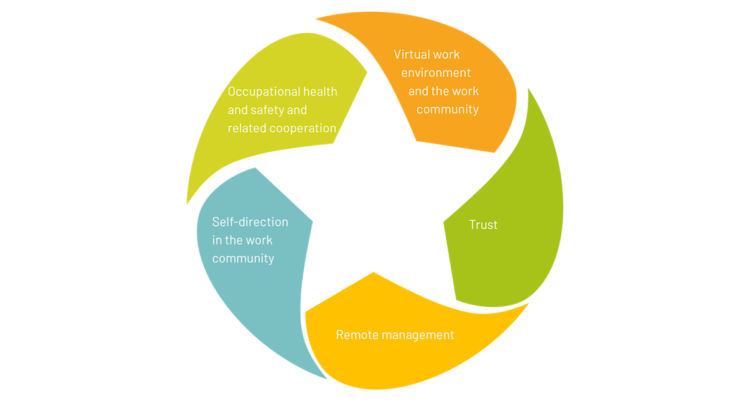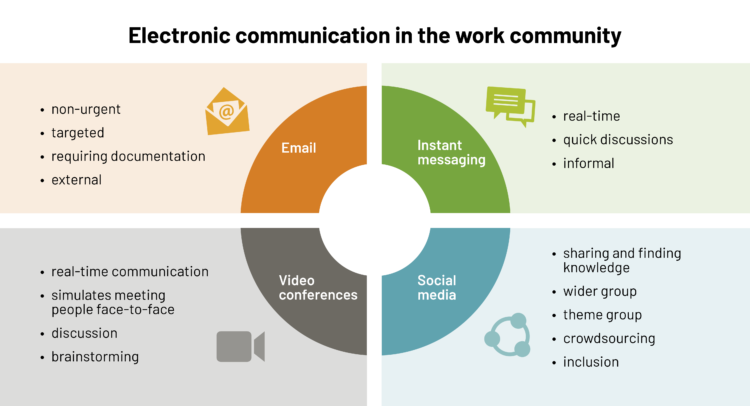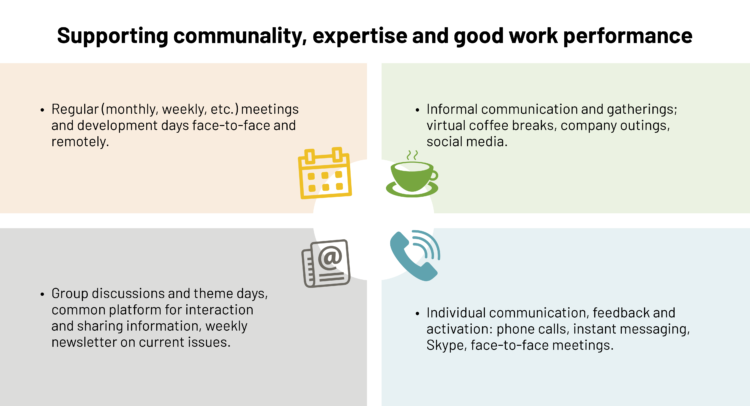Remote Management and Virtual Interaction in the Work Community

Sivun sisällysluettelo
Introduction
There are certain special requirements related to managerial work when the work community operates in a dispersed manner. Above all, remote management is about enabling cooperation and supporting self-direction. Self-direction as a strength, at both the individual and work community level, becomes particularly emphasized. Both the employee and the supervisor must be able to schedule and organize their own work. Remote and virtual management is commonplace in many expert tasks, office work and service professions where the supervisor oversees several different units or where the work is done on the customers’ premises.
The tasks of the remote manager can be summed up into three roles:
- showing the way
- developing cooperation
- coordinating operations.
Building relationships, trust, sense of community, interaction and practices related to the sharing of information are emphasized in remote management. The remote manager is also responsible for the smooth running of work processes, safe and healthy work conditions, the monitoring of workload and working hours, supporting work capacity, and creating the necessary conditions for occupational health and safety cooperation.

Virtual work environment and work community
A virtual work environment contains: technological solutions and tools, applications, platforms and services for tasks that are executed through different interfaces.
An increasing number of work communities operate in a virtual work environment, either partially or completely. The importance of a virtual work environment is emphasized in organizations that are geographically dispersed. As a result, a significant part of the interaction is done using electronic communication tools, such as email, telephone, instant messaging, telephone conferences, video conferences, electronic discussion forums, various document management systems, or a combination of these.
People work in different locations: there is on-site work on the employer’s premises or the customer’s premises, and remote work in various locations, e.g. at home. Employees need orientation and support to perform well at work and to identify hazards and manage risks in diverse work environments.
Things to consider in your work community:
- What requirements do remote management and technology-based communication set for physical work?
- How has mobile, multi-location work been taken into account in management and communication?
- Where, how and when is communication carried out?
- What kind of tools and applications do the employees need?
- What digital documents are used and how?
- What kind of information is shared electronically and how?
- Can everyone access the information they need?
- How extensive is the cooperation network that the employee interacts with?
- What kind of security policies are in place in the organization and what are their implications?

Virtually communicating work community
A virtual work community is a group of people whose members are dependent on each other’s contribution when working towards a common goal, but who are geographically dispersed in different locations and communicate with each other using various electronic means.
Virtual work communities are the organizations’ answer to the organizational challenges created by the changing business environment, such as the globalization of the economy, competition, customer demands, technological advances and the growing importance of information. Challenges related to work communities that operate entirely or in part in a virtual environment include geographical, organizational, cultural and temporal dispersion. The lack of face-to-face communication and social interaction must be taken into account.
Key success factors for a virtually communicating work community include:
- trust
- members’ strong commitment and community spirit
- effective communication and shared practices
- sharing and utilization of essential information
- self-direction.
Prerequisites and features of virtual interaction
Versatile and high-performance technology is a prerequisite for successful virtual collaboration. There are no one-size-fits-all technology packages, however, and it is important to make sure that the technology is suitable for the task.
Things to consider in your work community:
- What is online collaboration like?
- Do you use various chat applications, are you familiar with video conferences, telephone conferences, platforms used to edit documents simultaneously?
- Are there enough devices, interfaces, expertise and support in the form of services?
- What is the organization’s strategy for using virtual spaces: what applications and social media channels do you use and do not use?
Cultural diversity is both an asset and a challenge. It often leads to more diverse solutions, but it may also make communication more challenging. Culture has an impact on how members of the work community receive information, act and interact with each other. In addition to language differences, cultural differences related to the concepts of time and deadlines may pose a problem.
The supervisor should be aware of the differences in communication between different cultures. Meeting people face-to-face enables more open interaction and reduces misunderstandings. The supervisor acts as a role model in encouraging cooperation and sharing information.
Formal procedures and agreed rules are critical for the effectiveness of cooperation. Shared operating processes support the work of the virtual work community and have a positive impact on efficiency. In addition to communication methods, you should also agree on e.g. meeting practices, decision-making processes, work-related reporting and roles.
Sharing information helps members of the community to make the best use of their know-how. Virtual work communities are prone to communication gaps. Sharing information is not only about sharing the knowledge that members already possess, but also about searching for new information in their surrounding environment. Efficient information sharing requires appropriate communication tools, but the team members’ ability and willingness to actively participate in the sharing of information is just as important.
The technology used must be suitable for storing information, and the information must be easy to find. You should always choose the technology according to your needs, and everyone should have the necessary skills and the willingness to use the technology in their work.
Collaborative sharing of information is supported by a shared platform that everyone can help build and maintain by sharing their expertise.
It is important to be aware of who knows what, so that the necessary information and know-how can be obtained from the person in question when needed. Successful sharing of information promotes the efficient use of resources, improves the quality of decisions and reduces errors. Successful information sharing also has a positive impact on the community spirit of the group and on the satisfaction and motivation of its members.
The biggest barriers to sharing information in a virtual environment include:
- lack of trust between members
- deadlines and competing tasks
- limitations caused by technology
- tension caused by cultural differences
- failure to build a collective information system
- sharing insufficient information
- data security
- lack of support in problem situations.
The strengths of communities that operate mainly in a virtual environment include the exchange of information and the low impact of bias on the exchange of information, brainstorming and detailed preparation of information related to the task at hand. Applying information is seen as a challenge, which makes planning and coordination more difficult. Tacit knowledge, which is shared only in close cooperation, is also seen as a challenge. Dependence on technology reduces the creation and sharing of tacit knowledge within the organization.
Enabling informal modes of interaction should also be taken into account when considering communication. Since bumping into people and talking with them face-to-face, shared coffee breaks and other spontaneous encounters are rare in virtual communities, these communities should give thought to alternate practices and how to implement them together. Such alternatives may include coffee breaks held over video, shared recreational or hobby events and the utilization of social media. These practices can be used to build trust and the community spirit.
Things to consider in your work community:
- How is the training and orientation related to communication organized?
- How to get help in problem situations?
- How can the supervisor contact the employees?
- How to contact your supervisor or other members of the work community?
- What kind of meeting practices support interaction and the flow of work?
- How to make safety announcements and risk assessments?
- How to monitor work performance, workload and working hours?
- How to act in problem situations?
Trust
Trust is the most important success factor for a virtual community, and achieving it may be challenging. Trust plays an important role in the quality of cooperation, efficiency, successful communication and development. Trust also helps build commitment and communality and promotes creativity. Trust between the supervisor and subordinate is critical, as is the mutual trust between team members. From a managerial point of view, the supervisor must be able to assess the necessary level of supervision and to make sure that work performance is monitored adequately.
Virtual environments do not provide a natural shared social environment for building trust. Trust is built when people have the chance to meet each other face-to-face and build personal relationships. In a virtual environment, where relationships are more distant and people’s actions are less predictable, trust is even more important, and building it right from the start is critical.
Several researchers stress the importance of face-to-face interactions in building trust, but there is also evidence showing that trust can be built virtually. In these cases, mutually agreed communication methods, responding quickly and the role of the supervisor are critical. Barriers to building trust include failure in communication, in the retention of important information and in sharing current information.
Trust increases:
- courage of employees
- initiative, commitment
- energy, well-being, enthusiasm
- self-confidence, sense of responsibility
Trust is often built as a result of developing the community spirit, and its building blocks include reputation, common goals, commitment and care for others, i.e. the same elements as in traditional communities. Building trust takes time, however, and it is slow to develop. Trust is needed in virtual environments, but there is often not much time to build it. This may lead to the creation of so-called instant trust, which is sensitive and short-term in nature.
Instant trust is not based on individuals, but rather on actions and the idea that other members of the community are skilled in their work, and that the work community can succeed in the task assigned to them when everyone works together. Professionals have faith in the expertise of their colleagues. Instant trust allows people to focus on the task at hand, and the actual work helps maintain trust. Trust is built through initially agreed and adopted communication methods, and it requires constant communication about work tasks. Being proactive and responding quickly is important for building and maintaining trust.
Factors that promote the building of trust include:
- social, free-form communication
- being enthusiastic and showing it
- self-initiative
- knowing how to use relevant communication technology
- predictable communication behavior
- essential content of messages
- timely communication
- positive leadership and responding calmly to crisis situations
- commitment and optimism towards work expressed by members.
Remote management
Changes in the way that work is organized require expertise related to remote management. Remote management refers to a situation where the supervisor and employees do not see each other daily. In some cases, supervisors and employees may meet each other face-to-face only once or twice a year.
Remote management is a growing trend that has slowly started to become a part of everyday work life. In global companies, it is commonplace for team members to be located all over the world. There are also more and more Finnish organizations where people work from different regions, and the supervisor meets the employees only once or twice a year. Remote work is not limited only to large organizations, as micro companies may also have people working from different addresses.
In order for remote management to be successful, it often demands more from the supervisor than traditional management. The lack of physical contact makes taking care of the supervisor’s traditional responsibilities more challenging, and virtual managers need to be creative when it comes to e.g. structures and processes. These days, more and more supervisors need remote management skills, and remote management can be seen as one of the core competencies of a supervisor. Successful remote management also often gives the company a significant competitive advantage.
The role of the supervisor should be examined also from the perspective of the work community. Different members of the community may have different views on the role of the supervisor, or they may wish for the supervisor to take on a different role than what the supervisor deems appropriate. Support from the management, good organization of work and sufficient technological conditions support the grouping of the work community’s members. Remote management does not mean that there is less need for leadership and management, but rather that there is more need for good management skills.
Instead of traditional, control-focused managerial work, trust-based leadership is needed in decentralized work communities. Good remote managers are better at balancing between a human-oriented and a task-oriented management style. A result-oriented management style is well-suited for decentralized work. Remote managers lead their community with tasks and goals, not so much with working hours.
Issues that are emphasized in remote management:
- emphasizing the common goal
- meeting people face-to-face and via different means of communication
- individuality and different needs of employees
- diversity of work tasks
- diversity of worksites and their distances
- supporting communality, expertise and good work performance in the work community.

Remote management requires adequate resources, and the supervisor should plan their time use in such a way that there is enough time for managerial work.
Remote managers should focus on these issues:
- reachability, communication: being easily approachable via different channels, also regular face-to-face meetings
- building trust: open flow of information, rules, setting an example
- evaluation of work performance: clear objectives, schedules, reporting
- strengthening employee commitment to the organization: interaction, joint events
- making objectives clear
- building communication and collaboration processes
- diversity of the work community, different needs of employees, equal treatment
- workload monitoring: open atmosphere, exchanging news, making use of the expertise of occupational health care
- problem detection: open atmosphere, allowing mistakes and learning from them
- supporting communality: joint events, virtual forum, video coffee breaks, company outings
- adequate, individual guidance of people
- promoting cooperation between members of the work community
- establishing, monitoring and maintaining common rules and procedures
- adequate recognition, motivation, involvement and training of individuals
- recognizing and encouraging people who take responsibility within the community
- management by change.
Meeting people face-to-face is importat, because it
- makes a person feel more humane and empathetic through boby language, expressions and gestures and gives a more positive image of the person
- enables more open and honest interaction
- helps build trust and reduce misinterpretations
- promotes the flow of information and the development of competences
- enables the monitoring of workload and well-being
Different roles of the remote manager
Some of the roles assumed by the remote manager may seem to be in direct conflict with each other. In order to be efficient, the manager must be able to take care of several roles that may conflict with each other. They consist of roles related to the management of issues, communication and people.
Planner, organizer, creator of preconditions, and decision-maker.
Information officer, data collector, friendly face to talk to, facilitator of communication, and contact person.
Coach, relationship builder, problem solver, and facilitator of cooperation.
Supervisor, test your remote management skills by answering the following questions:
- Has everyone in your work community clearly understood the core mission of the organization and their own roles and responsibilities?
- Are you familiar with every member of your work community and their individual strengths and weaknesses?
- Are schedules and assignments realistic?
- Do you make sure that work and other things progress smoothly?
- Have you created communication practices for each employee?
- Do you know how to be both determined and understanding?
- Do you give enough feedback?
- Do you know how to support regular, timely communication?
- Do you value the opinions and suggestions of the members of your work community?
- Do you remember to show support, understanding and interest towards the members of your work community?
- Do you address problems and disruptions in a timely manner?
- Can you mentor team members on practical matters?
- Are you consistent and convincing?
- Do you act fairly?
- Do you look after the members of your work community and show empathy for them?
You get one point for each question that you answered “yes”. The maximum score is 15.
More than 10 points: excellent result.
7 –10 points: create a personal development plan for your remote management skills.
Less than 7 points: create a personal development plan for your remote management skills; additional training may be required.
Self-direction in the work community
The concept of self-direction refers to the team’s responsibility to perform and manage their everyday work tasks and that the members of the work community work together to handle some of the tasks traditionally assigned to supervisors. This often means independent planning and scheduling of work tasks, making decisions related to work tasks and self-initiated problem solving.
Self-direction does not eliminate the need for managerial work. On the contrary, a supervisor working outside the work community is extremely important for the success of the community. Because of the challenges of remote management, the supervisor must authorize the members of the work community to perform their tasks in a relatively independent manner. In order to be successful, the processes and management systems of the organization must also support the community’s independent way of working. Efforts must be made to find a balance based on trust, which includes the sensitivity to address problems when necessary.
In self-directed work communities, especially in expert tasks, it is sometimes possible to decide internally on the division of labor, how to solve the task at hand, on the monitoring of work progress, and on the compensation of possible absences. This, however, requires clear principles and preconditions that everyone agrees on.
Members of a self-directed community need training, orientation and continuous development of communal competences.
Self-direction requires
- initiative
- independence
- prioritization skills
- the ability to make decisions and solve problems
- work community skills
- coordination skills.
Occupational health and safety and related cooperation
The self-initiative present at the workplace and the application of legislation, agreements and other norms to different remote environments and to the people who work in these environments form the foundation for safe and healthy working conditions. The employer is responsible for the safety and health of all employees, including those working in a virtual environment. The employer has limited capacity to monitor working conditions, working hours and workloads in remote environments, so good cooperation practices should be developed for occupational safety management. The employees also have a responsibility to take care of and communicate about their own safety and that of their co-workers. As the relevant authority, the Occupational Safety and Health Administration in Finland gives instructions on and monitors the minimum requirements for working conditions and the work communities’ compliance with them.
The employer must ensure that the employees are instructed properly on how to identify and predict hazards in their work environment and to make safety observations and reports. Adequate expertise is required when assessing occupational safety and health risks.
It is the supervisor’s job to keep an eye on the state of the work environment, work atmosphere and results, and to enable the development of the organization’s competences also in virtual work environments. Making sure that no one is isolated from the rest of the community is especially important. A model for monitoring occupational well-being can be developed in cooperation with occupational health care and occupational safety personnel, in which the special features of the virtual work environment and remote management are taken into account.
The importance of orientation is emphasized in virtual environments. After a good face-to-face orientation, the new employee can quickly become part of the work community. An orientation plan and related material that take the special features of the work environment into account are needed at the workplace. Good orientation requires open discussion in the work community and the continuous development and implementation of orientation in changing circumstances and situations. The person undergoing orientation must also be active in the orientation process from the beginning, ask clarifying questions and give feedback.
Things to talk about during the orientation:
- core mission, goal and strategic priorities of the organization
- work tasks, objectives and areas of responsibility
- work facilities and work equipment
- workings hours
- working methods
- safe work practices and hazard detection
- work-related hazards and their prevention
- monitoring workloads and reporting them to the supervisor
- acting in abnormal and fault situations
- rules and procedures of the work community.
Conflicts, inappropriate treatment, harassment, workplace bullying
Good, proper work behavior is required of everyone in the work community. Keep in mind, however, that differing views are part of all work. Conflicts should be addressed and resolved in an open way, preferably between the concerned parties. Creating codes of conduct and guidelines for problem situations together helps prevent and solve problems.
It is more difficult for the supervisor to monitor the work atmosphere, the flow of cooperation, the division of tasks, the decision-making process and the exercise of power when there are no opportunities to be physically present and to meet people face-to-face. The employees also play an important role in resolving and reporting conflicts and work-related problems. This requires knowledge, training and support.
According to the Occupational Safety and Health Act, employees must avoid harassment and other inappropriate treatment of other employees at the workplace that causes hazards or risks to their safety or health. If such behavior occurs at work, the employer, after becoming aware of the matter, shall use all available means to take measures to remedy the situation.
Operating instructions for the supervisor
If your workplace has an existing operating model, act according to it. If there is no existing model, you can make a proposal to the occupational health and safety cooperation personnel about implementing one.
As the supervisor, you have the responsibility to address both internal harassment and harassment by clients, which is why you need the relevant training and skills.
When you receive a report of someone experiencing or witnessing harassment, you should take immediate action to resolve the situation. You may learn of harassment either from the employee in question, or via occupational health care, the shop steward or the occupational safety and health representative.
After learning of the harassment case, you must first investigate what has happened in an objective manner. It is recommended to initiate the investigation within two weeks of learning of it.
A face-to-face discussion is recommended for the investigation.
If necessary, you can get external expert help for investigating the situation from e.g. occupational health care. The employer is responsible for investigating the situation and taking necessary action.
Once the matter has been investigated, you should consider what kind of action is required to resolve the situation. The Occupational Safety and Health Act does not specify how cases of harassment should be resolved. If prohibited harassment occurs in the workplace, the employer must stop the harassment by all means available to them.
If the supervisor considers that there is harassment or inappropriate behavior taking place in the workplace, the supervisor has the right to prohibit such behavior. It is the supervisor’s responsibility to clearly state what kind of behavior is not acceptable in the work community.
Writing down the conclusions and relevant instructions and regulations is a good idea. If giving instructions and tips is of no help, the employer has the right to take disciplinary action, such as to issue the harasser a warning.
Occupational health and safety cooperation
Cooperation in occupational health and safety refers to cooperation between the employer and employees, the goal of which is to develop safe and healthy working conditions. It is in the employer’s best interest to take the employees’ knowledge of their own work into account and to welcome any suggestions on how to improve health and safety at work. The active participation of the employees is of critical importance for their safety, health and well-being. Occupational health and safety cooperation personnel act as experts in promoting healthy and safe working conditions in the workplace.
For the purpose of occupational health and safety cooperation, a so-called cooperative workplace must be defined. The concept of a cooperative workplace has an impact on representative cooperation and the election of the occupational safety representative.
A cooperative workplace is an entity consisting of one or more offices or operational units of the same employer. When defining a cooperative workplace, the nature and extent of the operations, the number of employees working in the operational units and the risks and hazards of the work must be taken into account. Several cooperative workplaces may be defined for one organization. A cooperative workplace may also consist of several different employers’ offices.
In a virtual work environment, it is important to secure the creation of good conditions for occupational safety cooperation through technological solutions, good meeting practices and information management, and to allow the occupational safety and health representative to perform their duties properly. As situations change, it is important to assess the flow of cooperation and develop operations.
Learn more about virtual communication tools and practices in the section Virtually communicating work community of this publication.
Cooperation in occupational health and safety refers to cooperation between the employer and employees, the goal of which is to develop safe and healthy working conditions. It is in the employer’s best interest to take the employees’ knowledge of their own work into account and to welcome any suggestions on how to improve health and safety at work. The active participation of the employees is of critical importance for their safety, health and well-being. Occupational health and safety cooperation personnel act as experts in promoting healthy and safe working conditions in the workplace.
For the purpose of occupational health and safety cooperation, a so-called cooperative workplace must be defined. The concept of a cooperative workplace has an impact on representative cooperation and the election of the occupational safety representative.
A cooperative workplace is an entity consisting of one or more offices or operational units of the same employer. When defining a cooperative workplace, the nature and extent of the operations, the number of employees working in the operational units and the risks and hazards of the work must be taken into account. Several cooperative workplaces may be defined for one organization. A cooperative workplace may also consist of several different employers’ offices.
In a virtual work environment, it is important to secure the creation of good conditions for occupational safety cooperation through technological solutions, good meeting practices and information management, and to allow the occupational safety and health representative to perform their duties properly. As situations change, it is important to assess the flow of cooperation and develop operations.
Learn more about virtual communication tools and practices in the section Virtually communicating work community of this publication.
Sources and more information
Contact us

- Published by:
- the Centre for Occupational Safety, Service Group
- Content:
- Petri Ellimäki, Private Employment Agencies Association HPL; Erika Kähärä, Service Union United PAM; Tanja Lehtoranta, Trade Union Pro; Lotta Savinko, Akava; Päivi Rauramo, Centre for Occupational Safety
- Release year:
- 2020
- Sectors:
- Private Service Sector
- Formats:
- Digital publication
- Language:
- englanti